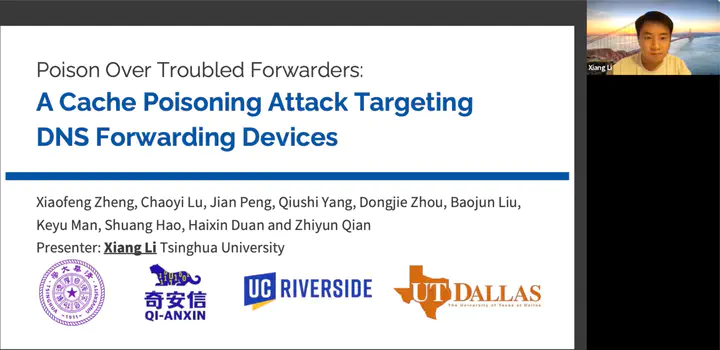Abstract
In today’s DNS infrastructure, DNS forwarders are devices standing in between DNS clients and recursive resolvers. The devices often serve as ingress servers for DNS clients, and instead of resolving queries, they pass the DNS requests to other servers. Because of the advantages and several use cases, DNS forwarders are widely deployed and queried by Internet users. However, studies have shown that DNS forwarders can be more vulnerable devices in the DNS infrastructure. In this paper, we present a cache poisoning attack targeting DNS forwarders. Through this attack, attackers can inject rogue records of arbitrary victim domain names using a controlled domain, and circumvent widely-deployed cache poisoning defences. By performing tests on popular home router models and DNS software, we find several vulnerable implementations, including those of large vendors (e.g., D-Link, Linksys, dnsmasq and MS DNS). Further, through a nationwide measurement, we estimate the population of Chinese mobile clients which are using vulnerable DNS forwarders. We have been reporting the issue to the affected vendors, and so far have received positive feedback from three of them. Our work further demonstrates that DNS forwarders can be a soft spot in the DNS infrastructure, and calls for attention as well as implementation guidelines from the community.
Date
May 25, 2021 12:00 PM — May 27, 2021 3:45 PM
In the 4th ICANN DNS Symposium (IDS 2021, virtually) , I presented a novel DNS cache poisoning attack (introduced by Xiaofeng Zheng from our lab) to the audiences.

Associate Professor
Xiang Li is an Associate Professor at the College of Cryptology and Cyber Science, Nankai University. He is the advisor of Nankai University’s CTF teams and Information Security Association, an ACM member, CCF member, and CIC member. He serves as PC for venues like CCS, IMC, RAID, ACSAC, DSN, AsiaCCS, and etc. His research interests include network security, protocol security, IPv6 security, DNS security, Internet measurement, network & protocol fuzzing, network vulnerability discovery & attack, web security, and underground economy with over 25 research papers. As the first author, he has published many research papers at all top-tier security conferences, including Oakland S&P, USENIX Security, CCS, NDSS, and Black Hat (Asia, USA, and Europe). He applied for 12 patents (2 authorized and 5 in checking as the first author). He has obtained over 250 CVE/CNVD/CNNVD vulnerability numbers, more than $11,600 rewards, 460+ GitHub stars, multiple CERT reports, 100+ news coverage, and RFC acknowledgement. He got multiple prizes, such as 2024 ACM SIGSAC China Excellent Doctoral Dissertation Award, 2024 Pwnie Award Nominations (Hacker Oscar), 1st prize of IPv6 Technology Application Innovation Competition, 1st place of GeekCon 2025 DAF Contest, 2nd place of GeekCon 2023 DAF Contest, National Scholarship, Wang Dazhong Scholarship, Tsinghua Outstanding Scholarship, Outstanding Graduate, and Extraordinary Hacker of GeekCon International 2024.
